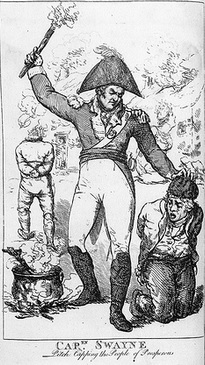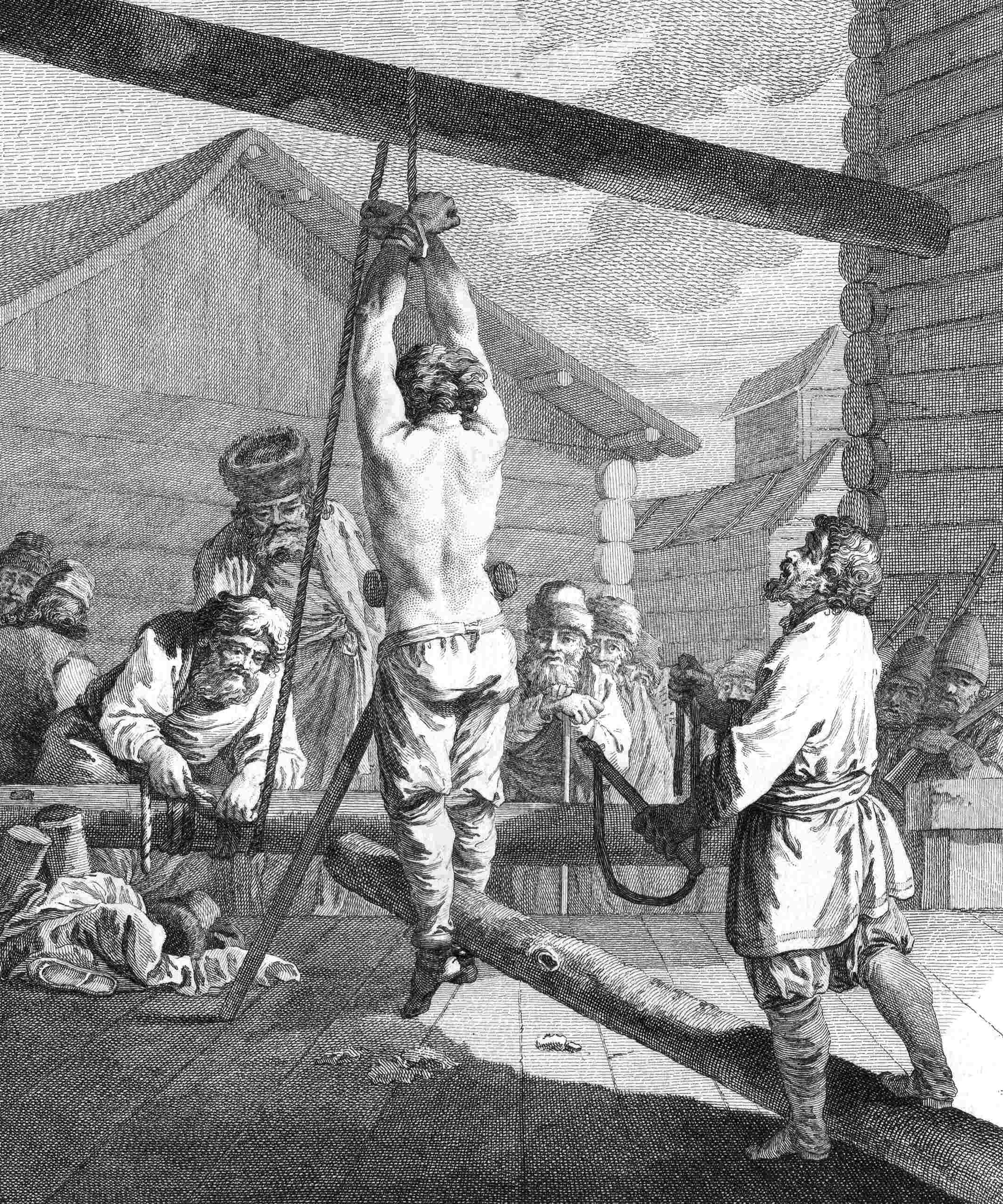|
Pitchcapping
Pitchcapping is a form of torture which involves pouring hot pitch or tar (mainly used at the time for water-proofing seams in the sides of ships and boats) into a conical paper cap and forcing it onto an individual's head, which is then allowed to cool before being rapidly removed. Typically, victims of pitchcapping suffer loss of skin and tissue around their head. The practise of pitchcapping dates back to the period of classical antiquity, but was used most prominently during the suppression of the Irish Rebellion of 1798. Pitchcapping was usually preceded by the hasty shaving of the victim's hair, and the effect it had resembled scalping in the injuries inflicted. In other forms of pitchcapping, pitch or tar was poured into the victim's orifices instead, though since doing so invariably proved fatal, this was more akin to a form of execution instead. Another form of pitchcapping involved smearing cloth or a piece of paper with pitch and pressing it onto the head of the vi ... [...More Info...] [...Related Items...] OR: [Wikipedia] [Google] [Baidu] |
Wexford Rebellion
The Wexford Rebellion refers to the events of the Irish Rebellion of 1798 in County Wexford. From 27 May until 21 June 1798, Society of United Irishmen rebels revolted against British rule in the county, engaging in multiple confrontations with Crown forces. The most successful and destructive rising in all the counties of Ireland, United Irishmen rebels experienced a number of early successes in the county despite being seen as a relatively loyal county by the Dublin Castle administration due to a series of military victories. However, the tide soon turned against the United Irishmen in Wexford as Crown forces poured into the region, engaging in a brutal counterinsurgency which indiscriminately targeted suspected rebels and eventually suppressed all rebel activities in the county. Background The County Wexford branch of the Society of United Irishmen had remained relatively intact during the government repression by the Dublin Castle administration which saw neighbouring ... [...More Info...] [...Related Items...] OR: [Wikipedia] [Google] [Baidu] |
Croppy
Croppy was a nickname given to Society of United Irishmen, United Irishmen rebels during the Irish Rebellion of 1798 against British rule in Ireland. History The nickname "Croppy" was used in Kingdom of Ireland, 18th-century Ireland in reference to the Pixie cut, cropped hair worn by Irish nationalism, Irish nationalists who were opposed to the wearing of Wig#18th century, powdered periwigs closely associated with members of the Protestant Ascendancy. They were inspired by the ''sans-culottes'' of the French Revolution, who also forewent the wearing of periwigs and other symbols associated with the aristocracy. During the Irish Rebellion of 1798 against British rule in Ireland, many Society of United Irishmen, United Irishmen rebels wore cropped hair, which led the Dublin Castle administration and government forces (in particular the militia and yeomanry) to frequently arrest anyone wearing the hairstyle as a suspected rebel. A form of torture known as pitchcapping was specifi ... [...More Info...] [...Related Items...] OR: [Wikipedia] [Google] [Baidu] |
Anthony Perry
Anthony Perry (c. 1760– 21 July 1798), known as the "''screeching general''" was one of the most important leaders of the United Irishmen, United Irish Wexford rebels during the Irish Rebellion of 1798, 1798 rebellion. Background Perry was born in County Down, Ireland to a Protestant family and lived a prosperous life at Inch, near the Wexford/Wicklow border as a gentleman farmer. He enlisted in the local yeomanry corps as a second lieutenant responding to the Government's appeal to save the kingdom from radicalism during the height of anti-Jacobin (politics), Jacobin paranoia in the mid-1790s. He took the United Irish Oath in 1797 and was made a colonel. As a United Irishmen, United Irish colonel, Perry was responsible for the organisation and recruitment of the movement in north Wexford. A measure of this success was evident by the fact that the brutal coercion campaign unleashed by the Government 1797–98 did not identify Wexford as a United Irish stronghold until barel ... [...More Info...] [...Related Items...] OR: [Wikipedia] [Google] [Baidu] |
Militia
A militia ( ) is a military or paramilitary force that comprises civilian members, as opposed to a professional standing army of regular, full-time military personnel. Militias may be raised in times of need to support regular troops or serve as a pool of available manpower for regular forces to draw from. When acting independently, militias are generally unable to hold ground against regular forces. Militias commonly support regular troops by skirmishing, holding fortifications, or conducting irregular warfare, instead of undertaking offensive campaigns by themselves. However, militias may also engage in defense activities to protect a community, its territory, property, and laws. For example, naval militias may comprise fishermen and other civilians which are organized and sanctioned by a state to enforce its maritime boundaries. Beginning in the late 20th century, some militias (in particular officially recognized and sanctioned militias of a government) act as profe ... [...More Info...] [...Related Items...] OR: [Wikipedia] [Google] [Baidu] |
Physical Torture Techniques
Physical may refer to: *Physical examination In a physical examination, medical examination, clinical examination, or medical checkup, a medical practitioner examines a patient for any possible medical signs or symptoms of a Disease, medical condition. It generally consists of a series of ..., a regular overall check-up with a doctor * ''Physical'' (Olivia Newton-John album), 1981 ** "Physical" (Olivia Newton-John song) * ''Physical'' (Gabe Gurnsey album) * "Physical" (Alcazar song) (2004) * "Physical" (Enrique Iglesias song) (2014) * "Physical" (Dua Lipa song) (2020) *"Physical (You're So)", a 1980 song by Adam & the Ants, the B side to " Dog Eat Dog" * ''Physical'' (TV series), an American television series *'' Physical: 100'', a Korean reality show on Netflix See also {{disambiguation ... [...More Info...] [...Related Items...] OR: [Wikipedia] [Google] [Baidu] |
Corporal Punishments
Corporal is a military rank in use by the armed forces of many countries. It is also a police rank in some police services. The rank is usually the lowest ranking non-commissioned officer. In some militaries, the rank of corporal nominally corresponds to commanding a section or squad of soldiers. The word is a contraction from the medieval Italian phrase ( f soldiers. While most Indo-European languages use this contraction, West Iberian languages use . Types * Lance corporal * * First corporal * Second corporal * Master corporal * Corporal major * Corporal of horse * Corporal of the field * Staff corporal By country Australia Corporal is the second lowest of the non-commissioned officer ranks in the Australian Army, falling between lance-corporal and sergeant. A corporal is usually appointed as a section commander, and is in charge of 7–14 soldiers of private rank. They are assisted by a second-in-command, usually a lance-corporal or senior private. A Corpo ... [...More Info...] [...Related Items...] OR: [Wikipedia] [Google] [Baidu] |
Mankurt
Mankurts are unthinking slaves in Chinghiz Aitmatov's novel '' The Day Lasts More Than a Hundred Years''. After the novel, in the Soviet Union the word came to refer to people who have lost touch with their ethnic homeland, who have forgotten their kinship. This meaning was retained in Russia and many other post-Soviet states. Origin According to Aitmatov's fictional legend, mankurts were prisoners of war who were turned into non-autonomous docile servants by exposing camel skin wrapped around their heads to the heat of the sun. These skins dried tight, causing brain damage and figurative zombification. Mankurts did not recognise their name, family, or tribe—"a mankurt did not recognise himself as a human being". Aitmatov stated that he did not take the idea from tradition but invented it himself.Dmitry Bykov, Лекции по русской литературе XX века. Том 4 (Moscow: Eksmo, 2019), p. 52: «народ этого не выдумал, это выду� ... [...More Info...] [...Related Items...] OR: [Wikipedia] [Google] [Baidu] |
Tarring And Feathering
Tarring and feathering is a form of public torture where a victim is stripped naked, or stripped to the waist, while wood tar (sometimes hot) is either poured or painted onto the person. The victim then either has feathers thrown on them or is rolled around on a pile of feathers so that they stick to the tar. Used to enforce unofficial justice or revenge, it was used in medieval Europe and its colonies in the early modern period, as well as the early American frontier, mostly as a form of vigilante justice. The image of a tarred-and-feathered outlaw remains a metaphor for severe public criticism. (" to excoriate" .e. "to flay"being itself a similar type of metaphor). Tarring and feathering was a very common punishment in British colonies in North America during 1766 through 1776. The most famous American tarring and feathering is that of John Malcolm, a British Loyalist, during the American Revolution. Early history The earliest mention of the punishment appears in orders ... [...More Info...] [...Related Items...] OR: [Wikipedia] [Google] [Baidu] |
Picket (punishment)
The picket, picquet or piquet was a form of military punishment in vogue in the 16th and 17th centuries in Europe. It consisted of the offender being forced to stand on the narrow flat top of a peg for a period of time. The punishment died out in the 18th century and was so unfamiliar by 1800 that when the then governor of Trinidad, Sir Thomas Picton, ordered Luisa Calderon, a woman of European and African ancestry, to be so punished, he was accused by public opinion in England of inflicting a torture akin to impalement. It was thought erroneously that the prisoner was forced to stand on the head of a pointed stake, and this error was repeated in the ''New English Dictionary''. The punishment required placing a wooden peg (of the sort used for tents or for a line for cavalry horses; "picket" etc. were originally alternative names for such pegs) in the ground with the exposed end facing upward. The malefactor was typically a private soldier who had disobeyed orders. One wrist was ... [...More Info...] [...Related Items...] OR: [Wikipedia] [Google] [Baidu] |
Half-hanging
Half-hanging is a method of torture, usually inflicted to force information from the victim, in which a rope is pulled tightly around the victim’s neck and then slackened when the victim becomes unconscious. The victim is revived and the process repeated. During the Irish Rebellion of 1798 against British rule in Ireland, government forces, in particular the militia and yeomanry, frequently used half-hanging against suspected rebels. A prominent victim of half-hanging was Anne Devlin, the housekeeper of Robert Emmet. See also * Hanging * Waterboarding Waterboarding is a form of torture in which water is poured over a cloth covering the face and breathing passages of an immobilized captive, causing the person to experience the sensation of drowning. In the most common method of waterboard ... * John Smith (housebreaker), who earned the nickname Half-hanged Smith after surviving a sentence of hanging References {{Reflist Corporal punishments Hanging Irish Re ... [...More Info...] [...Related Items...] OR: [Wikipedia] [Google] [Baidu] |
Flagellation
Flagellation (Latin , 'whip'), flogging or whipping is the act of beating the human body with special implements such as whips, Birching, rods, Switch (rod), switches, the cat o' nine tails, the sjambok, the knout, etc. Typically, flogging has been imposed on an unwilling subject as a punishment; however, it can also be submitted to willingly and even done by oneself in sadomasochistic or religious contexts. The strokes are typically aimed at the unclothed back of a person, though they can be administered to other areas of the body. For a moderated subform of flagellation, described as ''bastinado'', the soles of a person's barefoot, bare feet are used as a target for beating (see foot whipping). In some circumstances the word ''flogging'' is used loosely to include any sort of corporal punishment, including birching and caning. However, in British legal terminology, a distinction was drawn between ''flogging'' (with a cat o' nine tails) and ''whipping'' (formerly with a ... [...More Info...] [...Related Items...] OR: [Wikipedia] [Google] [Baidu] |






